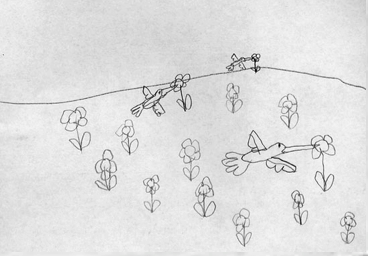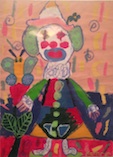Have you watched the children on the playground or in the classroom? Girls and boys play differently. They fight differently. They express themselves differently. Did you know they also hear and see differently? If given a chance by the teacher, boys and girls draw differently too.
Leonard Sax, author of 'Why Gender Matters', describes research about the differences in girls and boys eyes. The retina of the eye converts light, via photoreceptors into neurological signals. There are two types of photoreceptors, rods and cones. The retina has layers of rods and cones.
The Cones are smaller and thinner than the rods. They are concentrated around the eye's the field of vision. Cones are most sensitive to three different colours - red, green or blue. Cones are used for detecting detail, shape, texture and colour. The signal sent to the brain from the cones is converted into colour perception. They work in bright light. Females describe seeing many more colours than men. Cones are connected to P cells. The female retina has mostly P cells (parvocellular). Females have better peripheral vision and excel at visual memory compared to males.
The Rods are much larger than the cones. Rods are sensitive to dark and light changes, as well as to movement and shape. Rods are not sensitive to colour, they are therefore colour blind. The rods connect to M cells. The male retina has more M cells (magnocellular) than the female. Males' eyes are attracted to stimulus and movement, have better depth perception and distance vision.
If pre-school children were given a selection of crayons and blank paper, the following may be observed. The girls would generally draw static pictures, showing much detail and colour. While the boys, on the whole, would be drawing with much haste and speed, using predominately grey, silver, brown, blue and black. If the teacher asked what the boy was drawing, he would probably explain the picture as a speeding vehicle or an animal running quickly. Boys like to depict motion and girls like to depict detail and use much colour.
Look at the two drawings of two Gr. Rs
 |
The girl's picture is detailed, showing a clown in bright colours standing still. The boy's picture is in a garden, showing the birds collecting nectar from the flowers. The birds are flying to the flowers. The drawing is not coloured-in, it is just drawn in pencil. |
 |
As teachers, especially of little children we need to understand this. What often happens over time is the Pre-school or Foundation Phase teacher, who more often than not is a female, will compliment the girls on her 'beautiful' picture, and reprimand the boys saying his picture is not neat and tidy.
Instead we should be congratulating both girls and boys. Allowing both to explain their pictures and describing what the picture is about. We should not assume that the child, generally the boy, is just scribbling, rather ask the question: what is happening in your picture? Tell me about your drawing.
By commenting to the boys in a negative manner, he learns to draw neat, pretty pictures that the teacher will say she likes. At the same time we are limiting the boys creativity and originality. His eyes are wired to see movement, so he is trying to draw what he sees - things moving from place to place. While girls' eyes are wired to see detail, and that is what she is trying to depict.
Teachers could encourage both girls and boys to draw their pictures and to explain them, encouraging both to be freely creative.
The human eyes don't remain so different, by the age of thirty the gender differences are very small. Leonard Sax suggests the difference in vision between males and females is widest at age eleven.
By encouraging both types of drawings, girls and boys can learn from each other.
Other strategies teachers could consider in the classroom due to differences in vision at an early age and gender differences:
- Use mobiles, moving models or videos to demonstrate a concept or aspect of learning this will attract the boys' attention and keep them focused for longer. Boys' eyes are attracted to movement.
- Use spatial learning tools, such as building models, working with construction equipment or doing experiments, especially to engage the boys.
- Use pictures, descriptions or articles with much detail and information for girls to sift through. Encouraging girls to look detail.
- Grouping or sorting tasks by colour, shape or texture would interest the girls.

By recognizing the strengths and differences of both younger girls and boys we would be encouraging both to development and learn to their full potential. By exposing both boys and girls to the various types of activities they can learn from each other, without being made to feel inadequate or apprehensive.
Teachers should begin to understand the sequence of brain development and how it differs for boys and girls. This knowledge can help the teacher plan effective learning tasks for all their learners.
Resources:
Jensen, Eric. 2008. Brain-Based Learning The new paradigm of teaching. 2nd ed. Corwin Press, Sage Co. CA.
Sax, Leonard. 2005. Why Gender Matters: What Parents and Teachers Need to Know about the Emerging Science of Sex Differences. Random House, Inc. USA.






